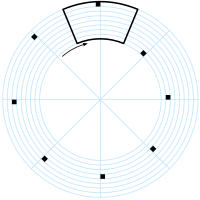Electromechanical television
Main article: Mechanical television
The Nipkow disk. This schematic shows the circular paths traced by the holes, that may also be square for greater precision. The area of the disk outlined in black shows the region scanned.
As a 23-year-old German university student, Paul Nipkow proposed and patented the first electromechanical television system in 1884.[1] Although he never built a working model of the system, variations of Nipkow's spinning-disk "image rasterizer" for television became exceedingly common, and remained in use until 1939.[2] Constantin Perskyi had coined the word television in a paper read to the International Electricity Congress at the International World Fair in Paris on August 25, 1900. Perskyi's paper reviewed the existing electromechanical technologies, mentioning the work of Nipkow and others.[3]
However, it was not until 1907 that developments in amplification tube technology, by Lee DeForest and Arthur Korn among others, made the design practical.[4] The first demonstration of the instantaneous transmission of still silhouette images was by Georges Rignoux and A. Fournier in Paris in 1909, using a rotating mirror-drum as the scanner and a matrix of 64 selenium cells as the receiver.[5]

No comments:
Post a Comment